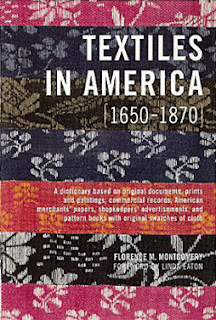Detail showing a worsted wool quilt
The wholecloth wool quilt is an 18th-century American tradition that continued into the 1840s, particularly popular in New England and New York. The major variations are worsted quilts, calimanco quilts and linsey quilts (more in another post).
The earliest Massachusetts bedquilt so far discovered by that state's project is thought to date from the 1730s, "a greenish-brown worsted whole-cloth quilt." Lynn Zacek Bassett has diagramed the quilting pattern in Massachusetts Quilts, but there is no picture of the textile by Mary Abbott Bridges. If you know what worsted is you can imagine.
Worsted is a harder, smoother yarn than woolen yarn.
Woolen on the left, worsted on the right.
I can never remember what worsted is so I looked it up. Like other textile terms its meaning varies and meaning changes over the generations. When discussing early wool quilts people use the word worsted to mean the following:
Worsted is also the cloth woven from that yarn. Florence Montgomery in her book on vintage textile terms (Textiles in America 1650-1870) says it was a "lightweight cloth made of long-staple combed wool yarn," named after an English village named Worstead.Worsted- straight, long, parallel fibers in the yarn, giving a hard, smooth surfaceas opposed toWoolen - looser, rougher yarn giving a softer, fuzzier surface
This quilt from an online auction looks to be a wholecloth worsted quilt. The quilting is not so fancy as in Mary Abbott Bridges's quilt.
The trouble with worsted fabric is that
it's hard to photograph because it absorbs the light
rather than reflecting it....
Which makes it dull.
So you don't find a lot of photos of worsted quilts.
See a picture of WillyWonky's wool wholecloth quilt here. It looks to be worsted
We see a new interest in wool comforters about 1890, often featuring woolens rather than worsted. The major difference between the early wool quilts and the later examples is that the early quilts are quilted. The later quilts are usually tied. The Amish continued the tradition of quilted wools and combination wool fabrics into the twentieth century, so identification is sometimes problematic, but a quilted wool wholecloth quilt is a good clue to an early date.
The early wool quilts were often quilted with a fine worsted yarn.
Fancy wool quilts were made from a polished wool called calimanco, something Montgomery defines as a worsted stuff with a fine gloss upon it...."plain weave glazed calimanco in sold colors of deep indigo, light blue green, raspberry red and pink....[Calimanco] is found in coverlets quilted in patterns of large flowers and leaves backed with coarser wool linings." (I'm still confused though-because there are satin-weave calimancoes too.)
Wholecloth calimanco quilt by Esther Wheat,
Conway, Massachusetts, estimated date: 1790.
Collection of the Smithsonian Institution
The reflective luster was obtained by calendaring the wool, running it through heated rollers that put a permanent polish on the fabric. Calimanco (calamanco), also called glazed wool, was usually an imported fabric, a luxury item. The shine remains and good photography highlights details in some beautiful quilts.
Calimanco was a popular clothing fabric in the 18th century, durable yet elegant. As it fell out of fashion it remained the clothing of the lower classes. One source of textile history is ads for runaway slaves, which often described clothing in detail as in this one from the New York Gazette in 1773, looking for Philis who absconded on Christmas wearing "a light couloured calimanco gown, a check apron, black silk cloak, and a black peelong bonnet..."
Calimanco was used for women's shoes too. Although it doesn't sound very sturdy surprisingly many
calimanco shoes have survived.
If you wanted to make a period wholecloth quilt you'd have a hard time finding the right wool today. You might be better off using a silk. Lynn Z. Bassett's drawings for Massachusetts Quilts will give you some design ideas.
See Lynn's essay on wool whole-cloth quilts in Kimberly Wulfuert's blog post by clicking here:
And more about the Massachusetts Quilts book here:
See several wholecloth wool quilts in the collection of the Bidwell House Museum by clicking here:
Read more about Esther Wheat's quilt here:
Florence Montgomery's 1984 dictionary of historical textiles has recently been republished with a foreward by Linda Eaton, textile curator at the Winterthur Museum. See a preview here:
http://www.amazon.com/Textiles-America-1650-1870-Florence-Montgomery/dp/039373224X#reader_039373224X
You might want to buy it directly from the Winterthur to support this important museum, its textile collections and its generosity in sharing information.
Read a preview of "Pretends to be free": runaway slave advertisements... By Graham Russell Hodges and Alan Edward Brown by clicking here:










3 comments:
Oh my gosh they wore kitten heels!
As always, thank you for the great research and most enjoyable showing and telling, Barbara.
"Worsted" you say? I'm around knitters who spin and I thought "worsted" mean a certain technique was used to spin the wool. I know I can't tell a worsted yarn from a woolen yarn, so I googled it. Turns out worsted means what you said (a certain preparation technique in which long fibres of wool are aligned parallel to each other end to end) and, in addition, a certain spinning short-draw technique and, of course, as knitters know, a certain size or weight of yarn no matter how prepared or spun. en.wikipedia.org/wiki/Worsted helped me parse all this out. But in Britain, "woolen" mills can make "worsted" fabric and I still can't tell one from the other. Thanks for shedding light on this! Really, you did! Someday I'll get it straight.
Hah. You and me both. The problem is textile terms change and they are used in different ways in different fields.
Post a Comment